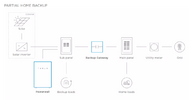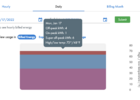"it depends"....
It depends on how your specific system was setup. What I believe you are asking is "are things in the main panel able to be use solar or powerwall power when the grid is connected"?
I believe the answer for this depends on how your specific system is setup, and where your CTs are. In my case, the answer is "yes, things in my main panel can be powered from solar and / or powerwall power, as long as the grid is up.
you should be able to test this on your system, though. Simply turn off the pool equipment electrical, while monitoring your tesla app and looking at your home consumption. You can try this first in the evening, if you have your powerwalls powering your home and no sun, and see if the draw from the powerwalls changes when you turn off or on the pool equipment.
if the powerwalls draw changes when you turn off / back on the pool equipment, then you know the powerwalls can power the pool equipment as long as the grid is connected.
If the powerwalls can power the equipment when the sun is down, then you know the solar can fill the powerwalls, so it would work how you want.
I remember
@holeydonut saying that he had difficulty getting alignment / agreement on non backed up loads being able to use solar + powerwall when grid was up.
As I mentioned, it works like this for me. The only thing I have in my main panel is a tesla wall connector, which will not work in a power outage, but is able to take solar and or powerwall power if the grid is connected.
Yeah,
@jjrandorin is right. Some folks on TMC have such smooth/perfect installs that work amazingly well with the latest tech. And others like me just get their face bashed in. When things go bad with solar and ESS, things get super frustrating.
I wager not every solar designer is as competent as
@Vines. In my experience, I simply could not find an installer willing (or able?) to do a partial home backup where the non-backup loads were metered. This includes 30 minutes of absolutely anger-inducing time on the phone with a Tesla Energy sales rep. I had a Tesla sales rep telling me that what I was asking for was impossible.
I believe the disconnect (pun definitely intended) can be described with the following diagram that Tesla provides to explain a partial home backup solution to customers. This is a similar flow chart you'll often see with LG Chem, Enphase and other PV+ESS systems in a partial home backup design. This diagram is obviously simplified to be used as marketing collateral. It is not really something a real system designer should use for reference.
So here's the problem. The "professional" and "trained" people I spoke with (the ones not named
@Vines) assume that the Powerwall is only able to store energy from the Solar, and then export that energy within the confines of the things in blue. No matter what.
No joke, I was told by at least 3 "experts" that...
... If the grid were operational, the battery is limited to the blue shaded items.
... If the grid were offline, the battery is limited to the blue shaded regions.
This is absolutely not the case.
So what
@jjrandorin was saying is that the Tesla Backup Gateway supports a current transducer (CT) connected to the red home loads. This allows the Tesla system to "sense" energy usage upstream of the Gateway. This is important for 2 reasons:
1)
If the grid is running, the Gateway can instruct the Powerwalls to export energy to serve the
backup loads AND the
not-backed-up home loads. If the Powerewalls cannot provide enough energy from this, the extra needed will come from the grid.
The benefit here is that stored energy can be used to power as many loads loads as possible so that you're using your own clean energy instead of taking bad energy from the utility. Again, remember, this only works with when the grid is operational.
I think, this is what was confusing these so-called-experts-not-named-Vines. They kept saying "just use energy from the grid to power the non-backup loads!!!" Why would you want to waste your Powerwall energy on loads you didn't back up? They could not grasp that PG&E and other IOUs have time of use rates. This means taking energy from the utility during peak time was bad.
Of course, you may want to reserve power for a blackout. So you can instruct the Powerwalls to hold a certain minimum charge and stop this upstream exporting if your stored energy hits a threshold.
Naturally if the grid goes offline, then the relay in the Gateway opens up and prevents any energy from being exported upstream of the Gateway. So this benefit of metered non-backup-loads is just a way to do time of use energy management or help you feel better that your own clean energy is being used for certain things.
Bottom line, using banked power from solar on non-backup loads was actually a benefit of having Tesla Powerwalls. I wanted this benefit. The Tesla Energy sales rep actually hung up on me telling me I was a competitor shill trying to waste his time. Beyond frustrating.
My first ever post on TMC was to see if I was completely off base and the Tesla Energy rep was right. I'm glad Tesla Energy was wrong.
2)
If your Tesla system can sense the upstream load, it'll help you to understand the complete picture of your total home energy consumption. Knowledge is power, and you'll benefit from knowing what energy your whole house is consuming instead of having the Tesla Energy system only see the backed-up loads.




